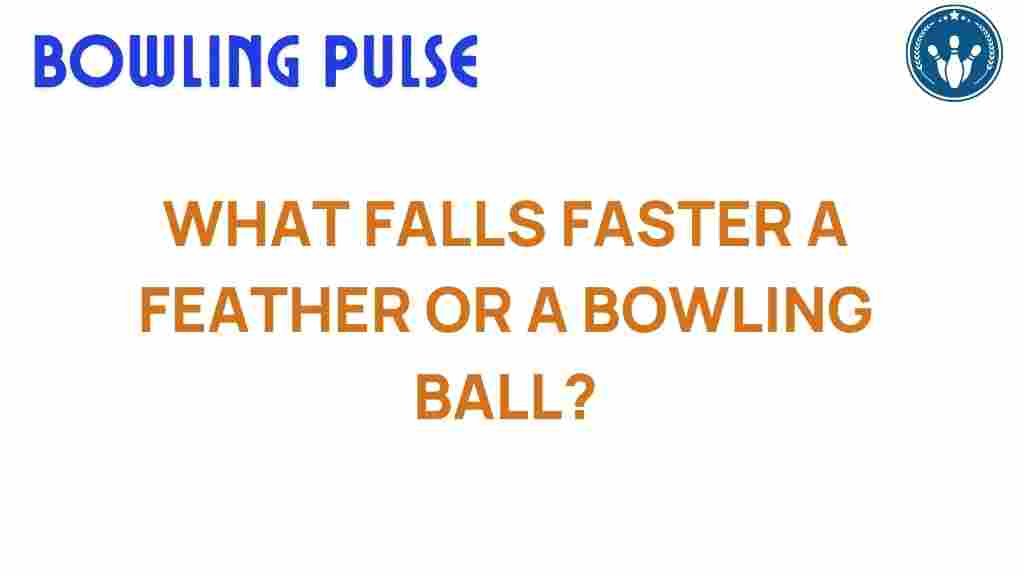The Gravity Challenge: Feather vs. Bowling Ball – Which Falls Faster?
When we think about gravity, the immediate question that comes to mind is: how does it affect different objects? The classic thought experiment of dropping a feather and a bowling ball raises a fascinating question in the realm of physics: which one falls faster? This article will delve into the science of gravity, acceleration, and the curiosity that surrounds this intriguing comparison.
Understanding Gravity and Acceleration
Gravity is a fundamental force that attracts two bodies towards each other. On Earth, this force gives objects weight and causes them to fall towards the ground when dropped. The acceleration due to gravity (denoted as g) is approximately 9.81 m/s². This means that, neglecting air resistance, all objects fall at the same rate regardless of their mass.
The Feather and the Bowling Ball: A Comparison
At first glance, the feather and the bowling ball seem to have drastically different falling behaviors. The feather is light and airy, while the bowling ball is dense and heavy. But how does gravity affect them? To understand this, we need to consider the concept of air resistance.
- Feather: A feather has a large surface area relative to its weight, which means it experiences significant air resistance. This resistance slows its descent considerably.
- Bowling Ball: In contrast, a bowling ball has a much smaller surface area relative to its weight, resulting in minimal air resistance. Thus, it falls more rapidly under the influence of gravity.
The Classic Experiment: Feather vs. Bowling Ball
To explore this question scientifically, we can conduct a simple experiment. Here’s how to perform it:
Materials Needed
- A feather
- A bowling ball
- A tall building or a safe elevated platform
- A stopwatch or timer
Step-by-Step Process
- Preparation: Ensure you are in a safe location where you can drop both objects from a height without risk to people or property.
- Drop the Bowling Ball: Hold the bowling ball at shoulder height and release it, starting the timer as it falls.
- Drop the Feather: Immediately after releasing the bowling ball, drop the feather and start the timer again.
- Observe the Results: Note how long each object takes to reach the ground.
What to Expect
When you conduct this experiment, you will likely observe that the bowling ball hits the ground significantly faster than the feather. This is primarily due to the feather’s interaction with air resistance, which greatly slows its fall.
Troubleshooting Tips
If you’re having trouble with your experiment or if the results are unexpected, consider the following:
- Wind or Air Currents: Ensure that the environment is still, as wind can affect the feather’s descent.
- Height of Drop: The height from which you drop the objects should be sufficient to allow for a noticeable difference in fall time.
- Feather Condition: Ensure the feather is free from any moisture or debris that might alter its weight or shape.
Scientific Explanation: Why Does This Happen?
The reason the feather falls slower than the bowling ball can be explained through the concepts of physics, particularly Newton’s laws of motion. According to Newton’s second law, the acceleration of an object depends on the net force acting upon it and its mass. The bowling ball, being more massive, has a greater gravitational force acting on it and experiences less relative air resistance compared to the feather.
In a vacuum, however, where there is no air resistance, both the feather and the bowling ball would fall at the same rate and hit the ground simultaneously. This was famously demonstrated by astronaut David Scott during the Apollo 15 mission when he dropped a hammer and a feather on the Moon.
Conclusion
The experiment of dropping a feather versus a bowling ball is more than just a demonstration of curiosity; it highlights the principles of physics and the impact of gravity and air resistance on different objects. The results clearly show that while both objects are subjected to the same gravitational pull, their interactions with air lead to vastly different falling behaviors.
By understanding these principles, we can appreciate the underlying mechanics of our world and foster a sense of curiosity about the science around us. For those interested in further exploring concepts of gravity and motion, resources such as The Physics Classroom provide excellent insights and experiments.
Next time you find yourself questioning the nature of gravity, remember this simple experiment and the profound insights it offers about our universe!
For more exciting experiments and scientific comparisons, visit our Science Experiments page.
This article is in the category Techniques and created by BowlingPulse Team
